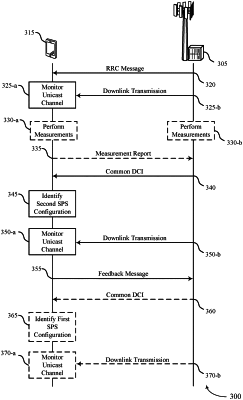| CPC H04W 72/23 (2023.01) [H04L 5/005 (2013.01); H04L 5/0051 (2013.01); H04W 16/26 (2013.01); H04W 24/02 (2013.01); H04W 36/20 (2013.01); H04W 72/121 (2013.01); H04W 72/1273 (2013.01)] | 28 Claims |

|
1. A method for wireless communication at a user equipment (UE), comprising:
monitoring a unicast channel using a first semi-persistent scheduling configuration for a first downlink transmission from a network entity, wherein the first semi-persistent scheduling configuration comprises a first set of parameters associated with a first coverage level;
receiving, from the network entity, a radio resource control message comprising an indication of a second set of parameters associated with a second semi-persistent scheduling configuration different from the first semi-persistent scheduling configuration;
receiving downlink control information that is common for a plurality of UEs, the downlink control information indicating the second semi-persistent scheduling configuration, the second semi-persistent scheduling configuration comprising the second set of parameters associated with a second coverage level of the unicast channel, the second coverage level being different from the first coverage level; and
monitoring the unicast channel for a second downlink transmission from the network entity using the second semi-persistent scheduling configuration comprising the second set of parameters associated with the second coverage level.
|